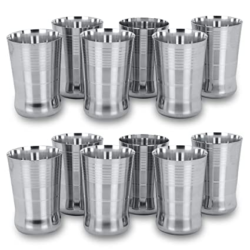Table of Contents
Uses of Alloys in Daily LifeCommon Uses of AlloysExamples of Alloys and Their ComponentsUses of Alloys and MetalsUses of Alloys in Industry
The use of pure metals for any specific industrial product is rarely seen because of some properties of the metals. A combination of different metals in varying ratios gives better products for usage. We could see more of such innovative products as more and more electronic and kitchenette items are developed. Alloys are combinations of metals or metals and other elements. The components of alloys are ordinarily metals, though carbon, a nonmetal, is an essential constituent of steel.
The use of pure metals is now a rarity as the main application and utility are from the longevity and durability of the product. Unless the metal objects are specifically used for high conductivity, ductility, corrosion resistance etc. the use of alloys is the need of the day. The reason for using alloys in day-to-day objects is mainly due to better durability and strength.



Uses of Alloys in Daily Life
- Alloying elements addition for specific designs and materials can often be accomplished without major reductions in the attributes associated with pure metals, like conductivity, ductility and resistance against corrosion.
- If two or more metals are mixed in the liquid state to produce a final solution, the resulting alloy is called a binary alloy. In the case of superalloys where the utility could be within a microwave cooker or baking oven as many as ten alloying elements may be used to obtain the desired performance.
- The use of alloy in daily life is now irrevocable and if the good factors like high tensile strength, and hardness are taken into consideration then materials like gas burners, microwave utility vessels, modern-day pressure cookers, pressure valves, washing machine tubs, grinder blades, and other simple daily use materials like vehicular parts of bikes and cars etc are produced.
- The metals nickel and copper completely dissolve into each other in a liquid state and retain their complete solubility in each other on freezing to form a series of alloys.
- When one type of metal is alloyed with another kind either substitutional or interstitial solid solutions are usually formed. Substituted solid-based solutions are considered for those where the atoms of both solute and solvent are of nearly the same size and the solute atoms simply substitute for atoms of solvents on the crystalline lattice.
- Interstitial solid solutions are those in which the solute atoms are found to be much smaller and fit within the spaces between the existing solvent atoms in the crystalline structure.
- The only solute atoms small enough to fit in the interstices of metal crystals are hydrogen, nitrogen, carbon and boron.
Common Uses of Alloys
- A typical metal is hard and shiny, tough as well as strong. It helps in conducting or carrying electricity and heat very well. Metals have thousands of uses in daily life and are often mixed or combined with other metals or substances to form alloys.
- Almost any machine or device which is used for precision instrumentation has at least one metal in it The best example of this is a steel alloy which is a combination of iron and little amount of non-metal carbon. The use of steel is universal and the day begins with utensils made of steel. The next very common kitchen vessel is aluminium and its alloys.
- The next daily use or rather universally used metal is gold which is worn by almost everyone. The ornaments made up of pure gold are never used by the public as they are found to be very soft and hence the use of copper or doping with copper makes it little wearable. The doped gold is relatively strong and doesn’t bend as easily as the pure form.
- The door locks and doorknobs are made up of brass which is an alloy form of zinc and copper.
- High-performance blades of jets or washing tubs or heating elements of microwaves and water heaters are again nothing but a doped form of pure metals.
- The common saucepans made up of aluminium never last long but if doped with little magnesium, copper or silicon make it tough enough to withstand high temperatures and deformation of metal could be prevented.
- The aircraft body made up of main aluminium is composed of doping with copper, magnesium and manganese which makes it tough, corrosion-free, lightweight and is widely used in aviation industries.
Examples of Alloys and Their Components
An alloy is a mixture that consists of a metal and one or more other elements with various sets of properties completely different from its component elements. The examples of alloys and their components are mentioned below.
- The use of alloys in gold-based ornaments with copper is well known for ages and is mainly used for making the ornaments durable and wearable. The presence of copper makes the gold ornament strong.
- The alloy brass is used for many home decorative items and is composed of copper and zinc. These metals combined make the brass strong and durable. The doorknobs and high-quality locks are all made up of brass.
- The alloy of bronze is used for making statues and medals as well as home decorations. Bronze is made up of tin and copper.
- The alloys brass and bronze mentioned above are of binary forms. Duralumin is ternary as there are four metals combined.
- Stellite is an alloy made up of four elements which are used by industries to make high tensile blades and machine parts. Stellite is composed of carbon, tungsten, chromium and cobalt.
- The alloy amalgam, used for many medical activities has silver, tin, copper, and zinc with mercury, indium, and palladium.
- The steel used in all kinds of constructions and industries is an alloy of iron and carbon, while stainless steel has nickel and chromium along with iron and carbon.
- The carbon steel alloy is used for weapon making, while in household items it’s used in high tensile blade making. These are used in grinders, blenders and juicers.
- The cookware cutlery and other major appliances like refrigerators and gas stoves, surgical instruments contain stainless steel which is mainly composed of carbon, chromium and nickel with iron as the main component.
Uses of Alloys and Metals
The utilization of different alloys is much diversified and the most common of the metal’s aluminium is given below.
| Alloy | Field of Application |
| Pure aluminium | Decoration strips, signs, foils, bottle caps, cans, toothpaste tubes and heat exchange lamellae |
| Alloy with 1% Mn | Cooking utensils, kitchen equipment, roofing and facing plates |
| Alloy with 2.5 – 4.5 % Mg | Food containers, boat |
| Alloys with 1% Mg | Decorative anodized materials |
| Cast alloys 10 % Si and 2.5 % Cu | Car cylinder blocks |
| Alloy with 0.5 % Mg and 0.4 % Si | Usually alloy for extruded profiles |
| Alloy with 0.7 % Mg and 0.4 % Si | Masts for sailing boats |
| Alloy with 1.2 % Mg and 5.5 % Zn | Car bumpers |
Copper-nickel system is used for hardening and strengthening and most of the solid solution system is caused by the distortion of the crystalline lattice of the base or solvent metal by the addition of solute metal. Distortion increases with the amount of the solute metal and maximum effect is found at the centre of the lattice.
Uses of Alloys in Industry
Alloy use in industry is very specific and while the main use of alloy is in either aviation or marine but the ancillary divisions are also involved in large-scale use of alloys.
The aircraft industry uses duralumin which is a main alloy of aluminium, marine engineering uses aluminium with silicon doping materials while other ancillary industries use stainless steel for all kinds of specific items. The medical industry uses stainless equipments as these are corrosion-free and can be disinfected easily.
Recommended Videos
Metallurgy

